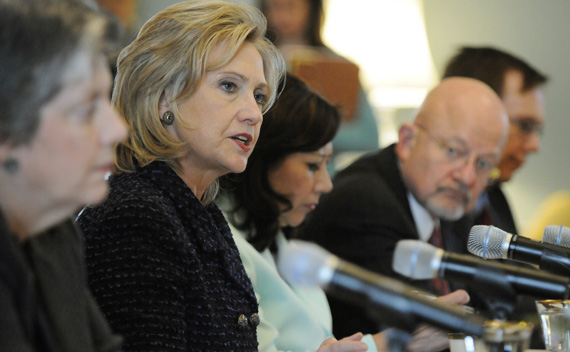Guest Post: State Department’s Human Trafficking Report

This Monday, the U.S. Department of State Trafficking in Persons Report was released. My colleague, Mark Lagon, adjunct senior fellow for human rights at the Council on Foreign Relations, offers his assessment.
More on:
Despite some eschewing petulant partisanship in foreign policy, it is rampant. However, the June 27, 2011 release of the 11th annual U.S. Department of State Trafficking in Persons Report is a tribute to a bipartisan policy that works.
The report assesses efforts worldwide to combat human trafficking, which enslaves victims for labor or sexual exploitation. Sometimes victims are moved across borders (like guest workers in construction in the Persian Gulf, or undocumented agricultural workers in Washington State which I’ve discussed with State Attorney General Rob McKenna), and sometimes not (like the estimated 100,000 prostituted minors in the U.S., or the millions of Dalits in bonded labor in India).
The report assigns countries one of four grades : “Tier 1” for fully meeting basic standards, “Tier 2” for governments making some efforts, ”Tier 2 Watch List” for those slipping, and “Tier 3” for negligible efforts). Combined with offers of aid and training for poorer nations, and an assessment of the United States’ own efforts (started in the Bush Administration and for two years now assigned a grade no less), these rankings propel other nations to face their trafficking problem. Even allies unused to U.S. pressure have been propelled to change—including Israel, Turkey, the Philippines, and the United Arab Emirates.
The report was created by bipartisan congressional action. In 2000, Christian conservative Senator Sam Brownback (R-KS) and the late firebrand progressive Senator Paul Wellstone (D-MN) collaborated to get the Trafficking Victims Protection Act signed into law. The State Department Trafficking Office it created has had strong bipartisan support, including when I headed it in 2007–2009.
More on:
Beyond grade hikes, this year’s report offers some good news. Where migrant workers and women are often treated as less than human, the Persian Gulf states have embraced an International Labor Organisation (ILO) convention on domestic workers rights. A paragon of democracy reclaimed, Chile, has finally passed a comprehensive trafficking law stalled since 2007. And the Philippines has confronted corruption and accelerated convictions of traffickers, mitigating the problem that justice delayed is justice denied.
Some State Department diplomats eager to preserve relationships for strategic and economic aims— allegedly more important than ending degradation— won internal bureaucratic battles to selectively grade some countries “on a curve.” Grading on a curve arose among those countries which already received the “Watch List” ranking for two previous years, which Congress mandated in 2008 needed to earn a higher ranking or get a special waiver, or else they would automatically be downgraded to “Tier 3” (worst).
For instance, while India ratified the U.N. Palermo Protocol, it has not successfully addressed its massive bonded labor problem (illegal since 1976). It does not deserve its Tier 2 ranking.
Uzbekistan surely deserved to be downgraded to “Tier 3,” rather than get a lawyerly wordsmithed waiver. Its government refuses to let ILO inspectors in to see if it is abiding by two ILO treaties on child labor it has ratified more than two years ago. A company not famous in the past for labor rights, Wal-Mart, refuses to buy Uzbek cotton because it is harvested by forced child labor. In a cruel irony, cotton-picking is at the heart of even this current instance of slavery.
Since the report came into being in 2000, 146 nations have ratified the Protocol and 128 have enacted comprehensive anti-trafficking laws. Three-quarters and two-thirds of the world’s nations is real progress.
Still, laws on paper aren’t enough. Implementation is lagging. The report’s data shows that last year, only 6,107 traffickers were prosecuted and 3,619 convicted (stagnantly similar to the level each year since 2004). Of them, only 607 were prosecuted and 237 convicted for labor-related trafficking desperate its prevalence. The U.S. justice system was responsible for fully one quarter of the latter (sixty-five).
Victim protection is arguably even more important than holding traffickers to account. Yet the number of victims identified worldwide dropped 32 percent from 49,105 in 2009 to 33,113 in 2010. Despite the awareness-raising report, U.S. and UN-sponsored training, and a year-long CNN campaign, trafficking victims are still being doubly victimized when treated by society and law enforcement as dirty, disposable, and deportable.
The report calls for a “Decade of Delivery” of implementation of pledges and laws on paper. Delivering requires two Bs. First, more businesses working together to scrub their supply chains and operations (like Internet-advertising) should join governments, international organizations, and nongovernment organizations in the anti-trafficking partnerships Secretary of State Clinton aptly touts.
Second, continued bipartisanship is crucial. Hopefully budget cutting and anti-immigrant fervor will not shake the consensus that contemporary slavery is a special concern to the United States, given the slavery in our past. Congress cut the State Department Trafficking Office’s lean budget by one-quarter this year. Yet it is heartening to see a Tea Party favorite, Senator Marco Rubio (R-FL), hail the report. Maybe on a foreign policy issue so grave, partisan differences can be left behind at the water’s edge.
 Online Store
Online Store
